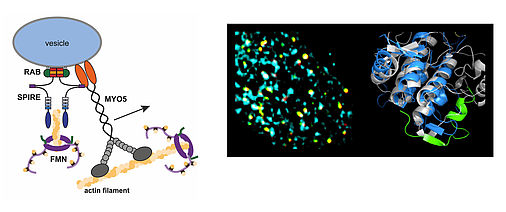
Department of Neurology / Molecular Cell Biology
Prof. Dr. Eugen Kerkhoff

Research focus:
Actin/myosin functions in exocytic vesicle transport processes
Animals have separated the essential demands of biological life into specialized regimes including food recognition, ingestion and digestion, sexual reproduction and enemy defence. Networks of communicating cells act as steering devices to coordinate the concerted actions of the animal organs.
Cell communication is mediated by secretion of signalling molecules, which interact with receptors on recipient cells. Intracellular transport processes facilitate the release of the signalling factors and the membrane integration of receptors. The signalling factors and the receptors travel on routes of the exocytic pathway. They are transported by motor proteins along microtubule and actin filament tracks to the cell periphery, where the vesicle fuse with the plasma membrane.
We have discovered a coodinated generation of actin filaments and myosin motor protein activation on exocytic/secretory vesicles and are experimentally addressing the evolution and function of actin force generation in secretory vesicle transport. Of special interest are neurosecretory processes and how they influence learning, memory and behaviour. We employ a variety of modern molecular cell biology methods including mouse genetics, fluorescence microscopy, protein interaction studies, structural biology and in vitro reconstitution.
Selected publications
- Alzahofi N., Welz T., Robinson C.L., Page E.L., Briggs D.A., Stainthorp A.K., Reekes J., Elbe D.A., Straub F., Kallemeijn W.W., Tate E.W., Goff P.S., Sviderskaya E.V., Cantero M., Montoliu L., Nedelec F., Miles A.K., Bailly M., Kerkhoff E., Hume A.N. (2020) Rab27a co-ordinates actin-dependent transport by controlling organelle-associated motors and track assembly proteins. Nat Commun 11: 3495.
- Pylypenko O., Welz T., Tittel J., Kollmar M., Chardon F., Malherbe G., Weiss S., Michel C.I.L., Samol-Wolf A., Grasskamp A.T., Hume A., Goud B., Baron B., England P., Titus M.A., Schwille P., Weidemann T., Houdusse A., Kerkhoff E. (2016) Coordinated recruitment of Spir actin nucleators and myosin V motors to Rab11 vesicle membranes. eLife 5:e17523.
- Welz T, Welbourne-Wood J, Kerkhoff E (2014) Orchestration of cell surface proteins by Rab11. Trends Cell Biol 24: 407-415.
- Pfender S, Kuznetsov V, Pleiser S, Kerkhoff E, Schuh M (2011) Spire-type actin nucleators cooperate with Formin-2 to drive asymmetric oocyte divisions. Curr Biol 21: 955-60.
- Pechlivanis M, Samol A, Kerkhoff E (2009) Identification of a short Spir interaction sequence at the C-terminal end of formin-subgroup proteins. Journal Biol Chem 284: 25324-25333.
- Quinlan ME, Hilgert S, Mees A, Mullins RD, Kerkhoff E (2007) Regulatory interactions between two actin nucleators, Spire and Cappuccino. Journal Cell Biol 179: 117-128.
- Quinlan ME, Heuser J, Kerkhoff E, Mullins RD (2005) Drosophila Spir is an actin nucleation factor. Nature 433: 382-388.
- Ciccarelli FD, Bork P, Kerkhoff E (2003) The KIND module: a putative signalling domain evolved from the C lobe of the protein kinase fold. Trends Biochem Sci. 2003 28: 349-52.
- Kerkhoff E, Simpson JC, Leberfinger CB, Otto IM, Doerks T, Bork P, Rapp UR, Raabe T, Pepperkok R (2001) The Spir actin organizers are involved in vesicle transport processes. Curr Biol 11: 1963-1968.
- Otto IM, Raabe T, Rennefahrt UEE, Bork P, Rapp UR, Kerkhoff E (2000) The p150-Spir protein provides a linkbetween JNK function and actin reorganisation. Curr Biol 10: 345-348.
Molecular Cell Biology
Prof. Dr. Eugen Kerkhoff
Dept. of Neurology
Franz-Josef-Strauß-Allee 11
93053 Regensburg
eugen.kerkhoff@ukr.de
Phone: +49 941 944 8924

